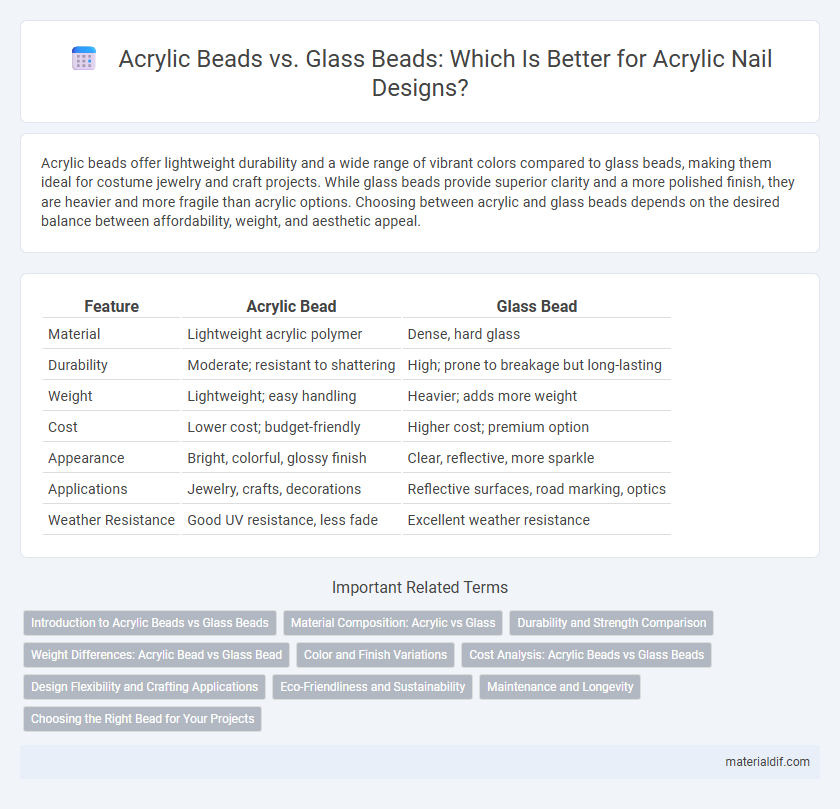Acrylic beads offer lightweight durability and a wide range of vibrant colors compared to glass beads, making them ideal for costume jewelry and craft projects. While glass beads provide superior clarity and a more polished finish, they are heavier and more fragile than acrylic options. Choosing between acrylic and glass beads depends on the desired balance between affordability, weight, and aesthetic appeal.
Table of Comparison
| Feature | Acrylic Bead | Glass Bead |
|---|---|---|
| Material | Lightweight acrylic polymer | Dense, hard glass |
| Durability | Moderate; resistant to shattering | High; prone to breakage but long-lasting |
| Weight | Lightweight; easy handling | Heavier; adds more weight |
| Cost | Lower cost; budget-friendly | Higher cost; premium option |
| Appearance | Bright, colorful, glossy finish | Clear, reflective, more sparkle |
| Applications | Jewelry, crafts, decorations | Reflective surfaces, road marking, optics |
| Weather Resistance | Good UV resistance, less fade | Excellent weather resistance |
Introduction to Acrylic Beads vs Glass Beads
Acrylic beads are lightweight, durable, and available in a wide range of colors and shapes, making them ideal for jewelry crafting and decorative purposes. Glass beads, made from melted and cooled silica, offer a higher level of clarity and brilliance, often preferred for upscale designs and intricate detailing. Comparing acrylic beads to glass beads reveals distinctions in weight, appearance, cost, and durability, catering to different creative and budgetary needs.
Material Composition: Acrylic vs Glass
Acrylic beads are made from polymethyl methacrylate (PMMA), a lightweight, shatter-resistant plastic known for its versatility and vibrant color retention. Glass beads consist primarily of silica sand, soda ash, and limestone, resulting in a denser material with a smooth, glossy finish and higher refractive index for enhanced sparkle. The material composition directly influences durability, weight, and visual properties, with acrylic beads offering greater impact resistance and glass beads providing superior clarity and brilliance.
Durability and Strength Comparison
Acrylic beads offer lightweight durability and are less prone to shattering compared to glass beads, which are brittle and more susceptible to breakage under impact. While glass beads provide a higher level of hardness and scratch resistance, acrylic beads excel in flexibility and shock absorption, making them ideal for jewelry and crafting that require resilience. The tensile strength of acrylic beads typically surpasses that of glass beads, enhancing their longevity in everyday wear.
Weight Differences: Acrylic Bead vs Glass Bead
Acrylic beads are significantly lighter than glass beads due to their lower density, typically around 1.18 g/cm3 compared to glass's 2.4-2.8 g/cm3. This weight difference makes acrylic beads ideal for jewelry and crafts requiring lightweight materials without sacrificing visual appeal. Glass beads offer greater durability but their heavier weight may impact comfort and design flexibility in wearables.
Color and Finish Variations
Acrylic beads offer a wider range of vibrant color options and finishes, including matte, glossy, iridescent, and transparent effects, which are difficult to achieve with glass beads. Glass beads typically provide a more uniform, polished finish with limited color variations, often constrained to classic or muted tones. The versatility of acrylic in color customization makes it ideal for dynamic, bold designs, whereas glass beads excel in traditional, elegant aesthetics.
Cost Analysis: Acrylic Beads vs Glass Beads
Acrylic beads are significantly more affordable than glass beads due to lower raw material and manufacturing costs, making them ideal for budget-conscious projects. Glass beads, while more expensive, offer superior durability and a higher-quality finish, which can justify the increased investment for premium applications. Cost efficiency of acrylic beads makes them popular in large-scale production, whereas glass beads are preferred when long-term wear and aesthetic value are prioritized.
Design Flexibility and Crafting Applications
Acrylic beads offer superior design flexibility compared to glass beads due to their lightweight nature and ease of shaping, making them ideal for intricate and customizable crafting projects. Their wide range of colors and finishes enables artisans to create vibrant and diverse designs that are difficult to achieve with traditionally heavier and more fragile glass beads. Acrylic beads are favored in crafting applications requiring durability and ease of manipulation, such as jewelry making, beadwork, and decorative accessories.
Eco-Friendliness and Sustainability
Acrylic beads demand less energy during production compared to glass beads, resulting in a lower carbon footprint. They are also lighter, reducing transportation emissions and packaging waste. However, glass beads are fully recyclable and degrade more naturally, offering a more sustainable end-of-life option.
Maintenance and Longevity
Acrylic beads require less maintenance than glass beads due to their lightweight and shatter-resistant properties, making them easier to clean and less prone to damage. Glass beads, while offering superior brilliance and durability, need careful handling and regular cleaning to prevent scratches and maintain their luster over time. The longevity of acrylic beads is generally shorter, as they tend to discolor and wear with prolonged exposure to sunlight and chemicals, whereas glass beads retain their clarity and structural integrity for many years with proper care.
Choosing the Right Bead for Your Projects
Acrylic beads offer lightweight durability and vibrant colors, making them ideal for jewelry and craft projects that require easy handling and comfortable wear. Glass beads provide superior clarity and a polished finish, enhancing elegance and visual appeal in high-end designs. Selecting between acrylic and glass beads depends on project needs such as budget, weight, and desired aesthetic impact.
Acrylic Bead vs Glass Bead Infographic

 materialdif.com
materialdif.com